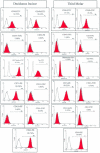In vitro Growth and Characterization of Stem Cells from Human Dental Pulp of Deciduous Versus Permanent Teeth
- PMID: 21998794
- PMCID: PMC3184765
In vitro Growth and Characterization of Stem Cells from Human Dental Pulp of Deciduous Versus Permanent Teeth
Abstract
Objective: By date investigations have indicated the presence of stem cells within the pulp tissue of both temporary and permanent human teeth. In the present study, these stem cells were compared in terms of their growth kinetics and culture requirements.
Materials and methods: Stem cells within the pulp of the human third molar (permanent tooth) and the deciduous incisor (temporary tooth) were isolated, culture-expanded and characterized. Then the proliferation potential of the cells was compared using multiple cell growth indices as PDT (Population doubling time), colonogenic activity and growth curve. Furthermore, the cultures of both cells were optimized for maximal proliferation.
Results: Stem cells of either pulp tissue appeared as fibroblastic cells capable of differentiating into osteoblastic, odontoblastic, adipocytic and chondrocytic cell lineages. In contrast to molar stem cells, those from the incisor tooth expressed neurogenic markers of ßIII Tubulin and Tau. Based on in vitro growth data, the cells from third molar tended to have a lower PDT value (20.79, SD=2.8 versus 25.55, SD=2.9 hours), higher colonogenic activity and better growth curve than those from the deciduous incisor (P<0.05). Both cells exhibited high expansion rate when being plated in a medium with 20% phosphate buffer solution at a density of 100 cells/cm(2).
Conclusion: Given the high proliferation capacity, the stem cells from the human third molar would be an appropriate candidate for use in experimental, preclinical and even clinical setups.
Keywords: Cell Differentiation; Cell Proliferation; Molar, Third; Tooth, Deciduous.
Figures







Similar articles
-
Phenotypic and growth characterization of human mesenchymal stem cells cultured from permanent and deciduous teeth.Indian J Dent Res. 2012 Nov-Dec;23(6):838-9. doi: 10.4103/0970-9290.111281. Indian J Dent Res. 2012. PMID: 23649079
-
Isolation and characterization of human dental pulp stem/stromal cells from nonextracted crown-fractured teeth requiring root canal therapy.J Endod. 2009 May;35(5):673-81. doi: 10.1016/j.joen.2009.01.019. J Endod. 2009. PMID: 19410081
-
Comparison of mesenchymal-like stem/progenitor cells derived from supernumerary teeth with stem cells from human exfoliated deciduous teeth.Regen Med. 2011 Nov;6(6):689-99. doi: 10.2217/rme.11.95. Regen Med. 2011. PMID: 22050521
-
SHED - Basic Structure for Stem Cell Research.J Clin Diagn Res. 2015 Mar;9(3):ZE07-9. doi: 10.7860/JCDR/2015/9871.5636. Epub 2015 Mar 1. J Clin Diagn Res. 2015. PMID: 25954717 Free PMC article. Review.
-
Insight into the Role of Dental Pulp Stem Cells in Regenerative Therapy.Biology (Basel). 2020 Jul 9;9(7):160. doi: 10.3390/biology9070160. Biology (Basel). 2020. PMID: 32659896 Free PMC article. Review.
Cited by
-
Effect of Periodontal Ligament Stem Cells-Derived Conditioned Medium on Gene Expression and Differentiation of Tumor Necrosis Factor-α-Challenged Osteoblasts.Eur J Dent. 2024 Feb;18(1):378-386. doi: 10.1055/s-0043-1771337. Epub 2023 Aug 10. Eur J Dent. 2024. PMID: 37562430 Free PMC article.
-
Growth kinetics and characterization of human dental pulp stem cells: Comparison between third molar and first premolar teeth.J Clin Exp Dent. 2017 Feb 1;9(2):e172-e177. doi: 10.4317/jced.52824. eCollection 2017 Feb. J Clin Exp Dent. 2017. PMID: 28210430 Free PMC article.
-
Human Dental Pulp Stem Cells Exhibit Osteogenic Differentiation Potential.Open Life Sci. 2020 May 6;15:229-236. doi: 10.1515/biol-2020-0023. eCollection 2020. Open Life Sci. 2020. PMID: 33987479 Free PMC article.
-
Paediatric dentistry- novel evolvement.Ann Med Surg (Lond). 2017 Dec 14;25:21-29. doi: 10.1016/j.amsu.2017.12.005. eCollection 2018 Jan. Ann Med Surg (Lond). 2017. PMID: 29326814 Free PMC article. Review.
-
Comparison of phenotype and differentiation marker gene expression profiles in human dental pulp and bone marrow mesenchymal stem cells.Eur J Dent. 2014 Jul;8(3):307-313. doi: 10.4103/1305-7456.137631. Eur J Dent. 2014. PMID: 25202208 Free PMC article.
References
-
- Seo BM, Miura M, Gronthos S, Bartold PM, Batouli S, Brahim J, et al. Investigation of multipotent postnatal stem cells from human periodontal ligament. Lancet. 2004 Jul 10–16;364(9429):149–55. - PubMed
-
- Morsczeck C, Moehl C, Götz W, Heredia A, Schäffer TE, Eckstein N, et al. In vitro differentiation of human dental follicle cells with dexamethasone and insulin. Cell Biol Int. 2005 Jul;29(7):567–75. - PubMed
LinkOut - more resources
Full Text Sources
